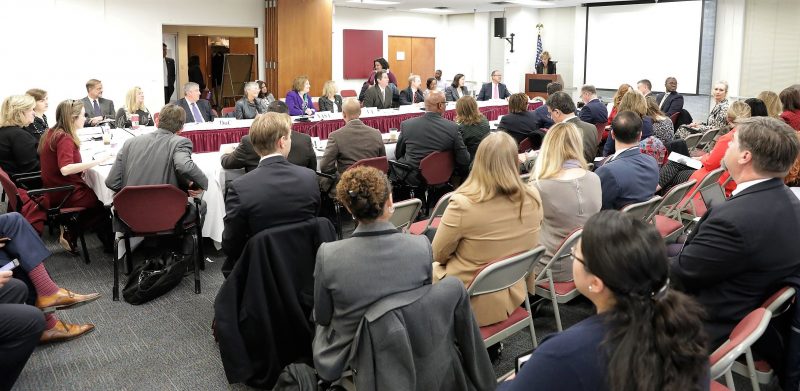As the season approaches for year-past reflections on progress and growth, the annual federal Chief Human Capital Officers (CHCO) Council public meeting forecasted a year ahead with room to grow in fostering a merit-based, nationally representative workforce.
Specifically, the federal government will look to expand workforce populations of military spouses and formerly incarcerated persons, while better managing poor performers.
“We need every person who is willing to work to come off of the sidelines,” said Margaret Weichert, Vice Chair of the Federal CHCO Council and Deputy Director for Management at the Office of Management and Budget (OMB).
CHCOs from around the federal government gathered at Office of Personnel Management (OPM) headquarters Monday morning to listen to sessions highlighting military spouses’ struggles in employment, former prisoners’ prospects through the 2019 Second Chance Act and the findings of the 2019 Federal Employee Viewpoint Survey (FEVS).
Weichert targeted improving diversity and inclusion as crucial to having a federal workforce that represents the country. She noted that performance management, a critical element to the workforce component of the President’s Management Agenda, can be driven by employee feedback, adding that intransigent, poor performers have “betrayed the trust of the American people.” A majority of federal employees say that poor performers remain in the workforce and do not improve, per the FEVS.
Newly appointed OPM director Dale Cabaniss led the opening remarks as the council chair. She described CHCOs as the link from agencies’ workforces to overall federal policy.
As the federal workforce comes out of a “tumultuous year” – as previously described by Dr. Kimberly Wells, Acting Director of OPM’s Office of Strategy and Innovation – CHCOs will now head up the job of turning 2019 priorities into 2020 successes, enabling a more effective and efficient government.
1. Hiring Federal Spouses
The difficulties of military spouses often go unreported, and when they are cast in the spotlight, very rarely are their career sacrifices noticed. A panel of military spouses shared their stories of struggling to find work while moving around the country and the world as members of military families.
Many, when journeying to remote locations, had to forfeit well-paying General Schedule (GS) positions to take GS-6, or similar-level, positions required to remain in the public service while relocating. For Joy Fisher, who traveled to Bahrain, Uganda and Japan to accompany her husband’s deployments, that loss of income amounted to $35,000 annually.
“It has been my privilege, but it has been difficult, and never once have I been able to use my spouse preference,” said Fisher, who re-entered federal service using a student pathway.
Public and private organizations can be part of the Military Spouse Employment Partnership (MSEP). Thirty percent of military spouses are unemployed, despite 88% having education beyond high school, Tracey Therit, CHCO of the Veterans Affairs Department, said.
Panelists recommended that agencies sign up for the MSEP, reach out actively to military spouses using social media and train hiring managers on how to read military spouse resumes, which can include sudden drops of salary or years of unemployment due to limited opportunities.
2.The Second Chance Hiring Initiative
About 70 million people in the U.S., the National Reentry Resource Center estimates, have an arrest or conviction record. And 95% of people who have been incarcerated in state prisons will be released back into their communities at some point.
The Second Chance Act guide helps formerly incarcerated people understand how to navigate USAJobs and the public sector employment pool. Certain agencies, such as the Justice Department and OPM, have set up programs to incentivize second chance hiring.
Formerly incarcerated people are unemployed at a rate of 27%, a higher figure than any overall unemployment rate ever in the U.S., according to the Prison Policy Initiative.
3.Creating a More Merit-Based Government
The 2019 FEVS found that 56% of federal employees say that poor performers in their work unit “remain in the work unit and continue to underperform.” Wells said there was room for improvement on this front but remarked that 34% of employees said either that poor performers have improved or there aren’t poor performers in their work unit.
Weichert also mentioned that performance management, a focus for the administration, could be driven by what agencies heard from employees. Speakers advocated for the FEVS as a way to gauge and synthesize this feedback, praising NASA, the State Department, the Homeland Security Department and the Health and Human Services Department as examples of how to stoke engagement in the survey, leading to more accurate and actionable findings.
CHCOs agreed that to receive high-volume, accurate data, leaders had to prove their commitment to responding to feedback. One fresh approach was equivalent to a digital “I Voted” sticker – an email signature that read, “I completed my FEVS, and I feel like I’m a better person.”





Leave a Reply
You must be logged in to post a comment.